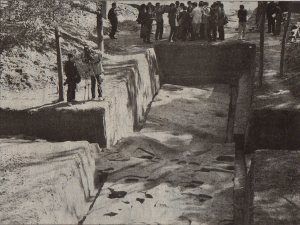Nara Pref. site matches description from ancient Nihon Shoki text

The Yomiuri Shimbun
The Yomiuri Shimbun Tuesday, November 15, 2005
NARA–The remains of five structures believed to be the seventh century house of Soga no Iruka, an influential figure in the Asuka period (592-628), were excavated from ruins in Asukamura, Nara Prefecture, according to officials of the National Research Institute for Cultural Properties.
The large structures were built in a valley at the foot of the Amakashinooka hill in the prefecture, which could be the Hazama no Mikado, which was the residence of Soga no Iruka, the officials said. Soga no Iruka was assassinated during the Taika Reform in 645.
Burned wall mud and other materials also were found, matching the house to the description in the Nihon Shoki (Chronicles of Japan), written in 720, the officials said.
The structures could become key evidence in shedding light on the Sogas, a clan characteristic of powerful regional families, and the Taika Reform, which led to sweeping changes in the country, the officials said. The site of the Amakashinooka Toroku remains is on the eastern foot of the Amakashinooka hill, about 600 meters norhtwest of the ruins of the capital of the Asuka period.
The site also is located about 600 meters to the southwest of Asukadera, the oldest Buddhist temple in the country, which was built by the Sogas, the officials said.
The top of the mountain ridge behind the hill commands a view of the Asuka capital dotted with the palaces of the emperors, including the Itabukinomiya Palace, where Soga no Iruka was killed.
After digging up about 730 square meters, excavators found pillar holes for five structures and the remains of walls at leatst 12 meters long, the officials said.
One of the structures was 10.5 meters wide, 3.5 meters long and has pillars 20 to 30 centimeters in diameter. Eathernware and burned soil and coal of the early seventh were found buried in a 8-centimeters in diameter next to one pillar hole.
The structures could be ware houses and the ruins of the main building are believed to be farther over on the east side, the officials said.
In 1994, burned wall mud, construction materails and earthware also were excavated from a slope south of the site.
According to the Nihon Shoki, in November 644, Soga Oomi Emishi and his son Iruka, built houses in Amakashinooka, with Oomi’s house called Kami no Mikado and Iruka’s Hazama no Mikado.
In June 645, the day after Iruka was assassinated, Emishi burned his and Iruka’s houses and committed suicide, the chronicle says.
Some researchers cautioned against determining the owner of the structure until the main building is discovered but the institute plans to continue research after next fiscal year in the belief that the main building and Kami no Mikado are in the vicinity.
The site is open to the public on Wednesdays from 10 am to 3 pm.
Kyoto University of Education Prof. Atsumu Wada said the Taika Reform was the biggest power struggle of ancient tmes in which the Sogas, who wielded trememndous power, were killed off and the Imperial family codified laws.
“One of the sites has been found. And it will be a very important clue to unravel that history,” he said.
****
Soga house believed found

A scroll depicts the burning of the Soga residence
Remains of residences and walls and burned soil found in Nara Prefecture have a good chance of being the residence of the Soga Family, a local ruling family of the seventh century, National Research Institute for Cultural Properties, Nara announced Nov. 13.
The son, Soga no Iruka, was the great power of the Asuka Period who even overshadowed the Imperial family. He was assassinated in the well-known coup d’etat of Taika no Kaishin (Taika Reform) in A.D. 645. Learning of his son’s death, Soga no Emishi set fire to his residence and killed himself.
Remains were found at the base of Amakashi-no-Oka hill in Asukamura, which Nihon Shoki (Chronicles of Japan) indicates as the location of Soga’s residence.
The Japan Times Weekly: Nov. 19, 2005
(C) All rights reserved

Very interesting. The fall of the Soga house was so dramatic!
These were my relatives. My name is C Soga.
Pingback: Prima delle grandi riforme: diplomazia, suicidi, e l’Incidente di Isshi – Fortezza Nascosta